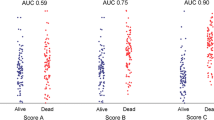Summary
Perioperative risk research with biomedical (biochemical, physiological) methods must grow up as a main topic in surgical research. However, operative risk has also to be analysed with methods of clinimetrics, such as formal (objective) decision making and epidemiology. Only by this way a convincing practical dimension is added to basic scientific statements. ASA-classification of the preoperative physical status is a global index for estimating the operative risk. It contains objective findings, subjective impressions and the final clinical judgement. For this reason it is so flexible. For a multicentre trial on perioperative risk and histamine an empirical index was constructed using both the ASA-classification and the Mannheim-Munich risk check list.
Zusammenfassung
Ursachenforschung beim perioperativen Risiko mit biomedizinischen (biochemischen, physiologischen) Methoden muss ein Schwerpunkt in der Chirurgie werden. Perioperatives Risiko muss auch mit den Methoden der Klinimetrie, wie objektiver Entscheidungsfindung und Epidemiologie analysiert werden. Nur so kommt zum wissenschaftlichen Ansatz auch eine überzeugende praktische Dimension. Die ASA-Klassifikation ist ein globaler Index zur präoperativen Risikoeinschätzung. Sie enthält objektive Befunde, den subjektiven Eindruck und das abschliessende klinische Urteil. Gerade deshalb ist sie so flexibel. Für die Mainz-Marburger multizentrische Studie über Perioperatives Risiko und Histamin" wurde ein empirischer Index aus ASA-Klassifikation und Mannheim-Münchner Risikocheckliste konstruiert.
Similar content being viewed by others
Literatur
Garfield E (1985) Journal citation studies. 45. Surgery journals: another operation in citation analysis. Current Contents — LS No. 21:3–18
Saklad M (1941) Grading of patients for surgical procedures. Anesthesiology 2:281–284
Böttcher S, Schuh FT (1987) Anaesthesiologische Zeitschriften: Versuch einer Bewertung mittels Zitatenanalyse. Anaesthesist 36:187–189
Dripps RD, Lamont A, Eckenhoff E (1961) The role of anesthesia in surgical mortality. JAMA 178:261–266
Memery HN (1965) Anesthesia mortality in private practice. JAMA 194:1185- 1188
National Halothane Study (1966) Summary. JAMA 197:775–788
Vacanti ChJ, VanHouten RJ, Hill RC (1970) A statistical analysis of the relationship of physical status to postoperative mortality in 68,388 cases. Anesth Anal 49:564–566
Marx GF, Mateo CV, Orkin LR (1973) Computer analysis of postanesthetic deaths. Anesthesiology 39:54–58
Owens WD, Dykes MHM, Gilbert JP, McPeek B, Ettling MB (1975) Development of two indices of postoperative morbidity. Surgery 77:586–592
Owens WD, Felts JA, Spitznagel EL (1978) ASA physical status classifications: a study of consistency of ratings. Anesthesiology 49:239–243
Turnbull KW, Fancourt-Smith PF, Banting GC (1980) Death within 48 hours of anaesthesia at the Vancouver General Hospital. Can Anesth Soc J 27:159–163
Hovi-Viander M (1980) Death associated with anaesthesia in Finland. Br J Anaesth 1980 52:483–489
Del Guercio LRM, Cohn JD (1980) Monitoring operative risk in the elderly. JAMA 243:1350–1355
Farrow SC, Fowkes FGR, Lunn JN, Robertson IB, Samuel P (1982) Epidemiology in anaesthesia. II: Factors affecting mortality in hospital. Br J Anaesth 54:811–817
Hatton F, Tiret L, Vourc' G, Desmonsts JM, Otteni JC, Scherpereel P (1983) Morbidity and mortality associated with anesthesia — French survey: preliminary results. In: Vickers MD, Lunn JN (Hrsg) Mortality in anaesthesia. Springer, Berlin Heidelberg New York, S 25–38
Schwam SJ, Gold MI, Craythorne WB (1982) The ASA physical status classification: a revision. Anesthesiology 57:A439
Keats S (1978) The ASA classification of physical status - a recapitulation. Anesthesiology 49:233–236
Ohmann C, Lorenz W, Stöltzing H, Thon K (1987) Grundlagen der Risikoforschung in der Chirurgie: Definition, Berechnung und klinische Anwendung auf das Problem der oberen Gastrointestinalblutung. Chirurg 58:344–351
Doenicke A, Lorenz W (1970) Histaminfreisetzung und anaphylaktische Reaktionen bei Narkosen. Biochemische und klinische Aspekte. Anaesthesist 19:413–417
Lorenz W, Doenicke A, Meyer R, Reimann H-J, Kusche K, Barth H, Geesing H, Hutzel M, Weissenbacher B (1972) Histamine release in man by propanidid and thiopentone: Pharmacological effects and clinical consequences. Br J Anaesth 44:355–369
Doenicke A, Lorenz W, Beigl R, Bezecny H, Uhlig G, Klmar L, Praetorius B, Mann G (1973) Histamine release after intravenous application of short-acting hypnotics: a comparison of etomidate, althesin (CT 1341) and propanidid. Br J Anaesth 45:1097–1104
Lorenz W, Seidel W, Doenicke A, Tauber R, Reimann H-J, Uhlig R, Mann G, Dormann P, Schmal A, Häfner G, Hamelmann H (1974) Elevated plasma histamine concentrations in surgery: Causes and clinical significance. Klin Wochenschr 52:419–425
Watkins J (1983) Etomidate: an “immunologically safe” anaesthetic agent. Anaesthesia 38:34–38
Schöning B, Lorenz W, Doenicke A (1985) Histamin H1- plus H2-Rezeptorenblockade als zusätzliches Prdmedikationsprinzip in der elektiven Chirurgie. Schweiz Rundsch Med (Praxis) 74:315–322
Messmer K, Lorenz W, Sunder-Plassmann L, Klövekorn W, Hutzel M (1970) Histamine release as a cause of acute hypotension following rapid colloid infusion. Naunyn-Schmiedebergs Arch Pharmacol 267:433 -445
Lorenz W, Doenicke A, Messmer K, Reimann H-J, Thermann M, Lahn W, Berr J, Schmal A, Dormann P, Regenfuss P, Hamelmann H (1976) Histamine release in human subjects by modified gelatin (Haemaccel ®) and dextran: An explanation for anaphylactoid reactions observed under clinical conditions? Br J Anaesth 48:151–165
Lorenz W, Doenicke A, Schöning B, Karges H, Schmal A (1981) Incidence and mechanisms of adverse reactions to polypeptides in man and dog. In: Hennessen W (Hrsg) Joint WHO/IABS symposium on the standardization of albumin, plasma substitutes and plasmapheresis. Geneva 1980. Dev Biol Stand 48:207–234
Ring J, Messmer K (1977) Incidence and severity of anaphylactoid reactions to colloid volume substitutes. Lancet 1:466–469
Richter W, Messmer K, Hedin H, Ring J (1978) Adverse reactions to plasma substitutes: incidence and pathomechanisms. In: Watkins J, Ward AM (Hrsg) Adverse response to intravenous drugs. Academic Press, London, S 49–70
Hedin H, Richter W, Messmer K, Renck H2 Ljungström K-G, Laubenthal H2 (1981) Incidence, pathomechanism and prevention of dextran-induced anaphylactoid/anaphylactic reactions in man. In: Hennessen W (Hrsg) Joint WHOAABS symposium on the standardization of albumin, plasma substitutes and plasmapheresis, Geneva 1980. Dev Biol Stand 48:179–189
Ring J, Seifert J, Lob G, Coulin K, Brendel W (1974) Humanalbuminunvertrdglichkeit: Klinische und immunologische Untersuchungen. Klin Wochenschr 52:595–598
Lorenz W, Doenicke A, Freund M, Schmal A, Dormann P, Praetorius B, Schürk-Bulich M (1975) Plasmahistaminspiegel beim Menschen nach rascher Infusion von Hydroxyäthylstärke: Ein Beitrag zur Frage allergischer oder anaphylaktoider Reaktionen nach Gabe eines neuen Plasmasubstitutes. Anaesthesist 24:228–230
Williams JG, Riley TRD, Moody RA (1983) Resuscitation experience in the Falkland Islands campain. Br Med J 286:775–777
Schreiber HW, Schwaiger M (1983) Verhandlungen der Deutschen Gesellschaft für Chirurgie. Langenbecks Arch Chir (Kongressber) 361:241–287
Pietsch-Breitfeld B (1987) 7th Meeting of the Permanent Working Party on Clinical Studies (CAS) of the German Surgical Society. Theor Surg 1:220–221
Häring R (1987) Das Risiko in der Chirurgie. Aktuel Chir (im Druck)
Lorenz W, Doenicke A (1985) Anaphylactoid reactions and histamine release by barbiturate induction agents: Clinical relevance and patho-mechanisms. Anesthesiology 63:351–352
Keats AS (1979) What do we know about anesthetic mortality? Anesthesiology 50:387–392
Feinstein AR (1983) An additional basic science for clinical medicine: IV. The development of clinimetrics. Ann Intern Med 99:843–846
Feinstein AR (1963) Boolean algebra and clinical taxonomy. N Engl J Med 269:929–938
Anonymous (1963) New classification of physical status. Anesthesiology 24:111
Dripps RD, Eckenhoff JE, Vandam LD (1972) Introduction to anesthesia. The principles of safe practice. Saunders, Philadelphia London Toronto, pp 3–9
Feinberg GL (1971) Obesity: class IV anesthesia risk. NY State J Med 71:2200–2201
Ahnefeld FW, Heinrich H (1983) Hat sich in der Routine des Anaesthesisten die Berücksichtigung von Risikofaktoren bewährt? Langenbecks Arch Chir (Kongressber) 361:263–267
Nemes C, Niemer M, Noack G (1985) Sicherheitsprobleme in der Anästhesiologie und Intensivmedizin. In: Datenbuch Anästhesiologie. Fischer, Stuttgart, S 390–395
Peter K, Unertl K, Wroblewski H (1986) Wertung der Risikofaktoren und peäoperative Untersuchungsprogramme. Anaesthesiol Intensivmed 181:45–46
Lorenz W, Ohmann C, Stöltzing H Thon K (1986) Grundlagen chirurgischer Indikationen: Hilfen zur Entscheidungsfindung. Langenbecks Arch Chir 369:57–63
Tannieres-Ruffie ML, Rius J, Levante A, Conseiller C (1981) Pre-operative assessment. Classification of risk. In: Conseiller C et al. (Hrsg) Complications of anesthesia, operative risk. Librairie Arnette, Paris, Excerpta Medica, Amsterdam, pp 285–324
Feldmann U, Osswald P-M, Hartung H-J, Luth H (1985) Computer aided methods to predict perioperative risks. In: Computers in critical care and pulmonary medicine. Springer, Berlin, S 162–183
Osswald PM, Hartung H-J, Feldmann U (1985) Prognostische Aussagekraft einer prdoperativen Risikocheckliste. Anaesthesist 34:508–512
Unertl K, Wroblewski H, Gliikher S, Henrich G, Rauch M, Peter K (1985) Das Risiko in der Anaesthesie. MMW 127:609–612
Author information
Authors and Affiliations
Rights and permissions
About this article
Cite this article
Lorenz, W., Dick, W., Junginger, T. et al. 31. Biomedizinische und klinimetrische Ansätze in der Ursachenforschung beim perioperativen Risiko: Erstellung einer deutschen ASA-Klassifikation. Langenbecks Arch Chiv 372, 199–209 (1987). https://doi.org/10.1007/BF01297815
Issue Date:
DOI: https://doi.org/10.1007/BF01297815




